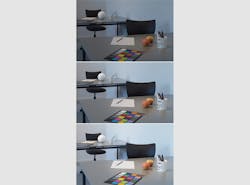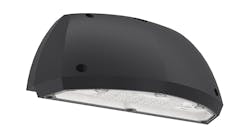A three-year research project at Aalborg University in Copenhagen focused on what is called Double Dynamic Lighting (DDL) has yielded positive results in terms of visual comfort among the four test subjects that participated in a field study. Fagerhult, iGuzzini (a Fagerhult company), Zumtobel, and Tridonic (a Zumtobel company), sponsored the DDL research that began in 2017. The approach is based on separate task and diffuse ambient light sources that are individually varied in intensity and spectrum based on natural light entering the workspace.
The project was originally launched with the title “Rethinking Light.” The research has included tests in office-working environments at the Aalborg lighting laboratories and in 3-D interactive computer models. In the simplest description of the research thesis, the team sought to determine if dynamic lighting would offer advantages in terms of worker comfort and productivity compared to typical static office lighting. The more complex angle of the work is using actual natural lighting conditions in real time to trigger the settings in the indoor space.
“The aim of the study is to apply an innovative mix of methods to create a holistic approach to lighting planning which can then function as a seal of quality in the lighting industry,” said Professor Ellen Katherine Hansen of Aalborg. “A combination of biological, aesthetic, and functional aspects will form the basis for the design process.”
You might expect that the researchers tried to mimic the outdoor environment and/or adhere to circadian and lighting for health and wellbeing principles in controlling the indoor environment — concepts we have covered repeatedly. But that is not what happened. Early Aalborg studies that preceded the field study revealed the need for artificial lighting to create shadow patterns and highlights that “emphasize the three-dimensionality of objects on work planes.” Moreover, the studies revealed the need for a working island or light zone for a user.
Related article: Spectral optimization shows potential to improve energy efficiency and quality-of-light experience
There was a further set of pilot experiments to study the appropriate ratios of direct:diffuse light needed to achieve the shadow patterns and other lighting qualities. Moreover, the pilot work focused on CCT or spectrum of the two sources of artificial light relative to clear sky and overcast conditions outside.
The field study included multiple desks in an open-office environment. For each of the desks, a directional luminaire supplied direct task lighting while troffer-like fixtures provided diffuse ambient light. Meanwhile, natural light entered the workspace via windows.
The field study involved the four test subjects working in the office space over a four-month period. The researchers tested seven different light settings. Moreover, the team used “sky-scanner” data and light intensity sensors as inputs to the control systems
The information released at the recent press conference used a couple of detailed examples of settings. On a day with clear sky outside, the direct task lighting was set to 3000K CCT while the ambient light was set to 5000–6000K CCT. Levels for the artificial light depend on the natural light intensity measured entering the room. Another example setting was tied to early evening with the sun beginning to set. The task lighting remained at 3000K while the ambient lighting was set to 4000K.
The published data further defined prescribed light level with the goal of delivering a total of 500 lx in the work-zone task level of the desk. During transitional times of the day in early morning and evening, the artificial light alone delivers 500 lx with 60% of the intensity coming from the ambient source. At other times of the day, 50% of the total lux comes from the natural light entering the room. You can read the Aalborg whitepaper for more details.
The field testing did not yield any quantifiable benefits. But interviews with the test subjects were universally positive to work under the DDL environment relative to work under static office lighting. One of the participants said, “I feel like when it’s overcast and the sun isn’t that much out, the lighting is kind of more comforting in the room, because it fills more.” Another said, “I noticed the light in the room, but it feels like the daylight and the light in the room are blended together, in a way. So, the weather is like casted into the room, projected.”
The researchers equated the dynamic mix and uneven distribution to achieving higher visible comfort for the test participants. Weekly questionnaires revealed positive effects for DDL relative to motivation, concentration, and workflow. The researchers even suggested that a larger diversity of exposure to different settings made a positive impact on work engagement.
The DDL research will continue. Among the next steps will be the introduction of circadian concepts and the response of the non-visual receptors. The work will also consider how reducing office light levels just to serve work zones can ultimately further reduce energy usage.
For up-to-the-minute LED and SSL updates, why not follow us on Twitter? You’ll find curated content and commentary, as well as information on industry events, webcasts, and surveys on our LinkedIn Company Page and our Facebook page.






